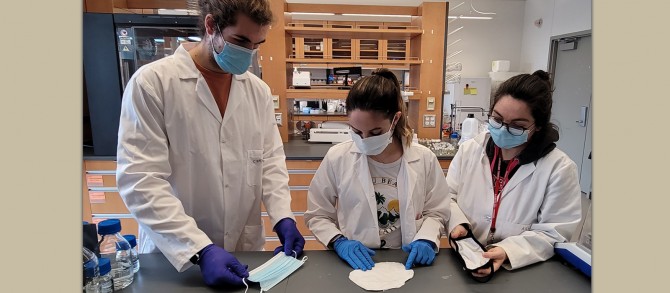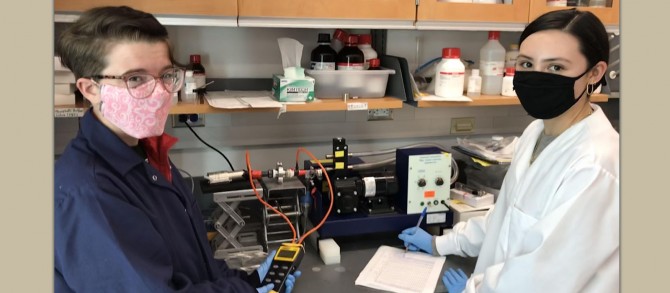News directly from Cornell's colleges and centers
Fit, function, fashion, sustainability - fiber science and apparel design researchers address face mask improvement
By E.C. Barrett
Even as the vaccine roll-out picks up speed, the end of face masks in public could be a year or more away as questions of transmissibility post-vaccine and effectiveness against emerging strains remain. One thing is clear: when it comes to fit, function, fashion, and sustainability, current face masks leave a lot of room for improvement.
Multiple ongoing research projects in the College of Human Ecology’s Department of Fiber Science & Apparel Design (FSAD) aim to improve the efficiency, breathability, comfort and environmental costs of face masks. The six projects, five funded through the Cornell Atkinson Center for Sustainability, highlight the depth and breadth of the research done in the only Ivy League department that brings fiber scientists, design experts, fashion creatives, fiber artists, and social scientists together in one program.
Antimicrobial biodegradable nanofibers to improve efficiency and sustainability
Dropped or discarded disposable face masks are a commonplace sight these days. Made of petroleum-based polypropylene fibers, disposal surgical and N95 masks are bad for the environment and the wildlife in it. Their singular function is to provide a physical barrier against viruses and bacteria, which can collect on the outside and inside of the mask.
Associate Professor Tamer Uyar, his postdoctoral researcher Asli Celebioglu and undergraduate students in his lab are developing biodegradable nanofiber mask inserts with naturally antibacterial materials to lighten the environmental costs of masks and improve their functionality.
The nanofiber inserts have a nano-porous structure with pore sizes that are much smaller than the size of viruses and bacteria, making them an excellent physical barrier to COVID-19. In addition, these nanofibrous mask inserts have antibacterial properties, offering users protection against bacteria they encounter or exhale throughout the day.
“Face masks can be a good platform for bacteria to attach itself, not only creating health concerns, but they can also produce bad odor, which makes the face mask uncomfortable,” Uyar said.
There are already masks that boast antimicrobial properties, but they come with a steep cost to the environment.
“They use silver nanoparticles, which is a very good antimicrobial agent, but at the same time, it creates a huge problem for the environment when it gets into the water stream,” Uyar explained. “There are many good bacteria out there that clean lakes, rivers and soils from pollutants by bioremediation, but the silver nanoparticles kill them. We’re making our nanofiber inserts biodegradable and antimicrobial without using silver nanoparticles, which makes them better for the user and for the environment.”
The students in Uyar’s lab are at work producing nanofiber inserts that he hopes to distribute for wear-testing this spring. He said combining his biodegradable and antimicrobial nanofiber inserts with the innovations in design and fit taking place in the rest of the department could result in masks that block 99 percent of airborne particles, making them more effective than the current gold-standard N95 masks.
Customized masks for better fit and function
One such innovation is a project from Associate Professor Juan Hinestroza to create personalized masks using face scans. Hinestroza’s lab would create an algorithm that takes a three dimensional object (the face) and translates it into a two dimensional item (the mask) which, when worn, becomes a three dimensional item. The scans would be sent to a manufacturing machine, such as an online retailer or even the local copy shop, that would make a mask customized to the unique characteristics of the user. This would make the masks more effective, more comfortable, and decrease waste.
“Instead of having to mass-produce masks that don’t fit anyone very well, and I’ve seen orders for 10 million masks that are all the same when we all have different faces, we could create a mask that fits the individual’s profile perfectly,” Hinestroza said.
He is applying for funding to pay students to work on the complicated math required to create the algorithm. Hinestroza sees this kind of on-demand fabrication technology as the future of clothing manufacturing that will provide items fit perfectly to individual shapes and sizes, while decreasing the massive amounts of waste created by the fashion industry and improve conditions for factory workers.
Selecting and decontaminating reusable mask fabric
Reusable masks come in a variety of shapes and fabrics, tend to be more comfortable to wear for long periods, and were a necessity when polypropylene disposable masks were in short supply at the start of the pandemic. But which fabrics make the most effective masks and do they remain effective after multiple washings?
Margaret Frey, the Vincent V. C. Woo Professor in FSAD, is testing the performance of a range of common woven and non-woven textiles made from a variety of fibers, such as cotton, polyester, and wool. Frey and graduate student Katarina Goodge ’23 (FSAD) developed a simulated breathing device to perform the test. They hooked up a single layer of each of the fabrics to a large animal ventilator, the kind that would be used to help a large dog with breathing problems, nebulized salt particles and tested how well the fabrics blocked the salt from passing through.
Frey and Goodge are also studying the efficacy of three popular home decontamination methods: laundry machine, dishwasher, and microwave. They are focused not only on how effective the methods are for cleaning, but how the different fabrics perform after many cleanings.
“Once we know how each layer works individually, we'll be able to create models of how they would work in multiple layers,” Frey said. “This is one of the benefits of pairing fiber science and apparel design. We noticed in the discussion around masks and even some of the published studies, there was very little understanding of the difference in the fibers being used. Our findings combined with fit studies and user-experience studies can be used as a design tool to create a better mask.”
Understanding the mask-wearing experience
The first of the projects to be completed was led by Associate Professor Denise Green along with Senior Lecturer Frances Kozen and Lecturer Catherine Blumenkamp, and will be published in a forthcoming open-access issue of the Clothing and Textiles Research Journal focused on COVID-19.
They conducted a demographically representative survey of 18-24-year-olds back in August, asking respondents about their mask-wearing habits, preferences, and experiences. The survey results revealed a wide-range of information, from how mask-wearing or not-wearing lined up with geographic location, race, gender, or political affiliation, to what improvements respondents would most like to see in mask design and construction. Over half of those surveyed wanted more breathable fabrics and a little over two-thirds wanted a better fit.
“Understanding user experience will help us to improve design,” Green said. “Through better design – which brings comfort, efficacy, and aesthetics together – we’ll improve mask compliance and help to mitigate the spread of COVID-19.”
Kozen is working on another project with Associate Professor Huiju Park and Senior Lecturer Kim Phoenix wear-testing three popular styles of masks to elicit data on comfort factors that affect user willingness to wear masks for a full day.
“Wear testing is used to evaluate consumer perceptions of garment comfort,” Kozen said, “as laboratory measures of textile properties or fit are one-dimensional and may not correlate well with the actual experience of moving in a garment over a period of time. It is a helpful tool for development of performance apparel and could be employed to assess designs or materials developed by other teams in FSAD.”
Kozen said they are about halfway through data collection, asking about issues like heat build-up, fogging, difficulty enunciating clearly through masks, and breathability.
Better masks for children
Children have a high risk of self-contamination when taking off and putting on their masks due to limited dexterity. They have difficulty maintaining social distancing in classrooms and their respiration rate is 30% higher than adults. That means longer exposure to airborne particulates and more chance to spread the virus to other people.
Project leader Huiju Park is working with Frey, Assistant Professor Fatma Baytar, Goodge and other graduate and undergraduate students on four goals: improving the design of children’s face masks, developing a head form and size guidelines based on anthropometric data, identifying optimal fabric and layer structure, and producing educational materials on best practices and fabric choices for caregivers, childcare workers, teachers and healthcare workers.
Utilizing an online survey, Park collected data on some of the biggest concerns and complaints from people responsible for caring for children ages 4-6 in one capacity or another. The major issues reported related to sizing and fit.
“Simply downsizing an adult face mask does not work,” Park said. “Children’s face and head shape proportions differ significantly from adult proportions. Children experience fit issues with commercial face masks, mostly revolving around general oversizing, lack of depth for facial features, and few shaping considerations around the sides and bottom of the mask that could help to prevent air gaps.”
Park’s team is working to develop methods for evaluating mask fit by using 3D body scanning technology and 3D virtual modeling, which will give them data to improve fit.
Using the simulated breathing apparatus developed by Frey and Goodge, adjusted for the higher respiratory rate of children, this project tested the filtration efficacy of available masks for children--data that can be used to further improve the design of masks.
While there has been some mixed messaging and lack of information around the risks of COVID-19 in children, Park pointed out that children experiencing even a mild infection can spread the virus and there are still too many unknowns on the effects to children.
“Infected children go through not only some typical symptoms, such as fever and breathing difficulty, but some experience Multisystem inflammatory syndrome in children (MIS-C), which is a very rare, new, unknown symptom. Unfortunately, there is no proven medicine or effective medical solution to this rare symptom as it is just so new. Nobody seems to have enough knowledge about this symptom and how it would impact children’s health from short-term and long-term perspectives. This is another reason that offering adequate protection through improved design of children’s masks is important.”
Park, an expert in protective and performance apparel, will turn next to creating a children’s face mask design based on the data his team collected along with the results of Frey’s fabric tests.
FSAD Professor and Chair Yasser Gowayed said there are other research programs around the world with projects working to identify and solve the problems and shortcomings of face masks, but none with FSAD’s depth and breadth.
“FSAD is unique because we do not study the problem from a single point of view. We integrate the social impact, the behavioral science and the physical science. This is only feasible because FSAD has scholars in these fields who can speak a common language and work together to present solutions that are not only efficient, but also grounded in reality.”
Media Contact
Get Cornell news delivered right to your inbox.
Subscribe




